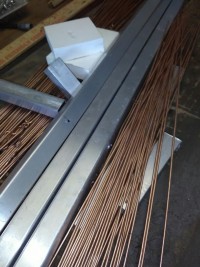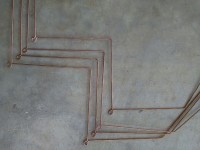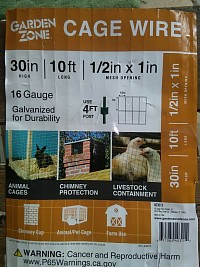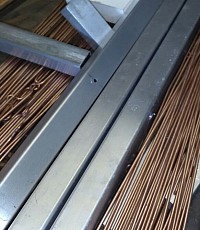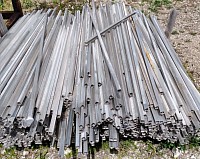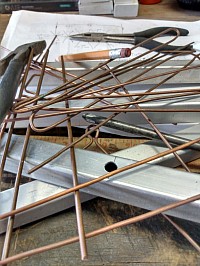GETTING STARTED
GATHERING
The video below goes over the materials that I use for my early experimental antennas. The aluminum and copper is a scrap yard find, but supply was limited. I learned what holds up in heavy weather through much trial and error here in hurricane country and your weather is something to think about. You can use any materials you want. Just keep in mind that for best performance your antenna should be mounted outside where it's subject to wind, rain and the damaging sun. Wood absorbs water, cheap fasteners rust and most plastics won't last in the sun. Inferior material is fine for a prototype or interior model but not a long lasting trouble free antenna. Use good stuff, get good results.
WIRE
There are many types of wire available in every size and material you can think of. For antenna construction the field narrows down. First and foremost we want good conductivity so electrons can flow freely on the driven elements. A solid core wire is next on the list. Stranded wire lacks the stiffness needed to form the various shapes of the elements. Then comes size measured in guage. Good working sizes are 12, 10 or 8 guage, the wire gets bigger as the number gets smaller. Most builders use a 10, with 12 being almost as good. 8 ga is just difficult to work with but workable. Last is metal, copper is best followed by aluminum for conductivity. Any other metals should be avoided if possible. Wire should be bare metal and free of corrosion for best results
BENDING
Below is a nice technique I use to bend wire. Rounded flowing curves are best, try to avoid sharp right angle bends and sharp V bends. The electrons should be able to flow up and down the element freely, the less impedance the better. With this method you have a bit more control keeping the mark centered and your measurements accurate. Practice on some scrap until you get the feel. I use two methods this one, SIMPLE BENDING METHOD and the more secure method below.
REFLECTOR MATERIAL
THEM BONES...
SCRAP YARDS
Most Recycling type centers only take in metals and whatever, they don't often sell to individuals. What you need is a Surplus type operation, one that buys and sells meatals and other useful material to the public. There you should be able to find suitable materials at a price you can live with. Surplus yards often only charge for the cost of the material, by the pound, no matter what its shape or size you only pay the current price of the metal. This can save you BIG bucks over the same material from a hardware or home store. For someone building one or two antennas you can usualy buy exactly what uou need for your project. Do a search locally and make some calls. You may have to clean things up with some sandpaper or steel wool but the savings are significant.
MISTAKES AND SCRAPS
Never throw material away. Save everything. Cut something wrong or drill holes in the wrong place, set it aside and save it. You never know when a piece that you thought was trashed will be the one to save the day. Besides being expensive, saving scraps gives you stuff to experiment with without using new material.
CREATE A PLAN
Look around this site for a design that suits your needs, the info you need is usually in the first section. Study it, then Plan your project in steps.
Do some leg work finding and gathering materials. Look for a deal wherever you can, new material from a hardware store can get expensive.
Create a workspace, if you don't already have one. You often need plenty of room to work. You will be making a mess, be neat.
Don't try to do everything in one afternoon. DONT RUSH. Take your time, you'll have better results.
Gather the tools you need. Good wire cutters, needle nose pliers, end cutter pliers, a hammer, a box cutter, Good Screwdrivers, etc.
Most of all, Enjoy building something you can use everyday.
Knowledge is free, pass it on.

